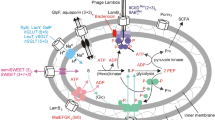Abstract
Uridine monophosphate (UMP) kinase converts UMP to the corresponding UDP in the presence of metal ions and ATP and is allosterically regulated by nucleotides such as UTP and GTP. Although the UMP kinase reported to date is Mg2+-dependent, we found in this study that the UMP kinase of Helicobacter pylori had a preference for Mn2+ over Mg2+, which may be related to a conformational difference between the Mn2+-bound and Mg2+-bound UMP kinase. Similar to previous findings, the UMP kinase activity of H. pylori UMP kinase was inhibited by UTP and activated by GTP. However, a relatively low GTP concentration (0.125 mM) was required to activate H. pylori UMP kinase to a level similar to other bacterial UMP kinases using a higher GTP concentration (0.5 mM). In addition, depending on the presence of either Mg2+ or Mn2+, a significant difference in the level of GTP activation was observed. It is therefore hypothesized that the Mg2+-bound and Mn2+-bound H. pylori UMP kinase may be activated by GTP through different mechanisms.







Similar content being viewed by others
References
Bradford MM (1976) A rapid and sensitive method for the quantitation of microgram quantities of protein utilizing the principle of protein-dye binding. Anal Biochem 72:248–254
Brignola PS et al (2002) Comparison of the biochemical and kinetic properties of the type 1 receptor tyrosine kinase intracellular domains. Demonstration of differential sensitivity to kinase inhibitors. J Biol Chem 277:1576–1585
Briozzo P et al (2005) Structure of Escherichia coli UMP kinase differs from that of other nucleoside monophosphate kinases and sheds new light on enzyme regulation. J Biol Chem 280:25533–25540
Chao TC, Huang H, Tsai JY, Huang CY, Sun YJ (2006) Kinetic and structural properties of inorganic pyrophosphatase from the pathogenic bacterium Helicobacter pylori. Proteins 65:670–680
Evrin C et al (2007) Regulatory mechanisms differ in UMP kinases from gram-negative and gram-positive bacteria. J Biol Chem 282:7242–7253
Fassy F et al (2004) UMP kinase from Streptococcus pneumoniae: evidence for co-operative ATP binding and allosteric regulation. Biochem J 384:619–627
Gagyi C et al (2003) UMP kinase from the Gram-positive bacterium Bacillus subtilis is strongly dependent on GTP for optimal activity. Eur J Biochem 270:3196–3204
Gamble RL, Coonfield ML, Schaller GE (1998) Histidine kinase activity of the ETR1 ethylene receptor from Arabidopsis. Proc Natl Acad Sci USA 95:7825–7829
Guy PM, Carraway KL III, Cerione RA (1992) Biochemical comparisons of the normal and oncogenic forms of insect cell-expressed neu tyrosine kinases. J Biol Chem 267:13851–13856
Jeong JY et al (2000) Sequential inactivation of rdxA (HP0954) and frxA (HP0642) nitroreductase genes causes moderate and high-level metronidazole resistance in Helicobacter pylori. J Bacteriol 182:5082–5090
Jong A, Yeh Y, Ma JJ (1993) Characteristics, substrate analysis, and intracellular location of Saccharomyces cerevisiae UMP kinase. Arch Biochem Biophys 304:197–204
Labesse G et al (2002) Comparative modelling and immunochemical reactivity of Escherichia coli UMP kinase. Biochem Biophys Res Commun 294:173–179
Larsen TM, Benning MM, Rayment I, Reed GH (1998) Structure of the bis(Mg2+)-ATP-oxalate complex of the rabbit muscle pyruvate kinase at 2.1 A resolution: ATP binding over a barrel. Biochemistry 37:6247–6255
Lee MJ, Huang CY, Sun YJ, Huang H (2005) Cloning and characterization of spermidine synthase and its implication in polyamine biosynthesis in Helicobacter pylori strain 26695. Protein Expr Purif 43:140–148
Lee MJ, Liu CH, Wang SY, Huang CT, Huang H (2006) Characterization of the Soj/Spo0 J chromosome segregation proteins and identification of putative parS sequences in Helicobacter pylori. Biochem Biophys Res Commun 342:744–750
Meyer P, Evrin C, Briozzo P, Joly N, Barzu O, Gilles AM (2008) Structural and functional characterization of Escherichia coli UMP kinase in complex with its allosteric regulator GTP. J Biol Chem 283:36011–36018
Pasti C, Gallois-Montbrun S, Munier-Lehmann H, Veron M, Gilles AM, Deville-Bonne D (2003) Reaction of human UMP-CMP kinase with natural and analog substrates. Eur J Biochem 270:1784–1790
Schinkmann K, Blenis J (1997) Cloning and characterization of a human STE20-like protein kinase with unusual cofactor requirements. J Biol Chem 272:28695–28703
Schuck P (2000) Size-distribution analysis of macromolecules by sedimentation velocity ultracentrifugation and lamm equation modeling. Biophys J 78:1606–1619
Serina L et al (1995) Escherichia coli UMP-kinase, a member of the aspartokinase family, is a hexamer regulated by guanine nucleotides and UTP. Biochemistry 34:5066–5074
Serina L et al (1996) Structural properties of UMP-kinase from Escherichia coli: modulation of protein solubility by pH and UTP. Biochemistry 35:7003–7011
Su JY, Erikson E, Maller JL (1996) Cloning and characterization of a novel serine/threonine protein kinase expressed in early Xenopus embryos. J Biol Chem 271:14430–14437
Yamanaka K, Ogura T, Niki H, Hiraga S (1992) Identification and characterization of the smbA gene, a suppressor of the mukB null mutant of Escherichia coli. J Bacteriol 174:7517–7526
Zhang H, Ishige K, Kornberg A (2002) A polyphosphate kinase (PPK2) widely conserved in bacteria. Proc Natl Acad Sci USA 99:16678–16683
Zhou L, Thornburg R (1998) Site-specific mutations of conserved residues in the phosphate-binding loop of the Arabidopsis UMP/CMP kinase alter ATP and UMP binding. Arch Biochem Biophys 358:297–302
Acknowledgments
This research was supported by the National Science Council, Taiwan (NSC93-3112-B007-016 and NSC95-2311-B-007-013).
Author information
Authors and Affiliations
Corresponding author
Additional information
Communicated by David Kelly.
Rights and permissions
About this article
Cite this article
Lee, MJ., Chien-Liang, L., Tsai, JY. et al. Identification and biochemical characterization of a unique Mn2+-dependent UMP kinase from Helicobacter pylori . Arch Microbiol 192, 739–746 (2010). https://doi.org/10.1007/s00203-010-0600-x
Received:
Revised:
Accepted:
Published:
Issue Date:
DOI: https://doi.org/10.1007/s00203-010-0600-x




